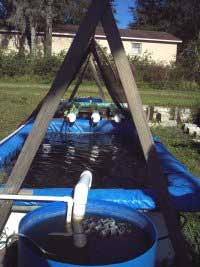| Bay Soundings | volume five o number one | winter 2006 | ||||||
| COVERING TAMPA BAY AND ITS WATERSHED | ||||||
|
|
Home-grown AquaponicsHome-grown aquaponic systems can provide families with hundreds of pounds of fish and fresh vegetables year-round. The system at the Morningstar facility, shown below, was built with easily available materials including concrete block and plywood, a waterproof tarp, a plastic barrel and PVC piping. A complete aquaponic system can be built in approximately 150 square feet, although some larger systems cover many acres. The smallest pond is typically about 500 gallons. Under average conditions, three gallons of water are required for each fish, and every 10 gallons of water in the tank supports two square feet of growing area for vegetables. Most aquaponic systems use tilapia, a warm-water fish native to Israel where it has been farmed for 2500 years, because theyâre extremely fast growing, tolerate poor water quality and use a wide variety of plant-based foods, including duck weed growing on the surface of the water. |
|||||
|
|
||||||
|
||||||


 A 500-gallon tank can produce about 150 pounds of fish per year, with fish typically harvested every six months at about 1.75 pounds. Tilapia are considered to be highly efficient fish, gaining approximately one pound for every 1.5 pounds of food they are fed. In most home systems, fish should be fed commercial fish food three to four times daily, but automatic feeders are available for families who arenât home during the day.
A 500-gallon tank can produce about 150 pounds of fish per year, with fish typically harvested every six months at about 1.75 pounds. Tilapia are considered to be highly efficient fish, gaining approximately one pound for every 1.5 pounds of food they are fed. In most home systems, fish should be fed commercial fish food three to four times daily, but automatic feeders are available for families who arenât home during the day.